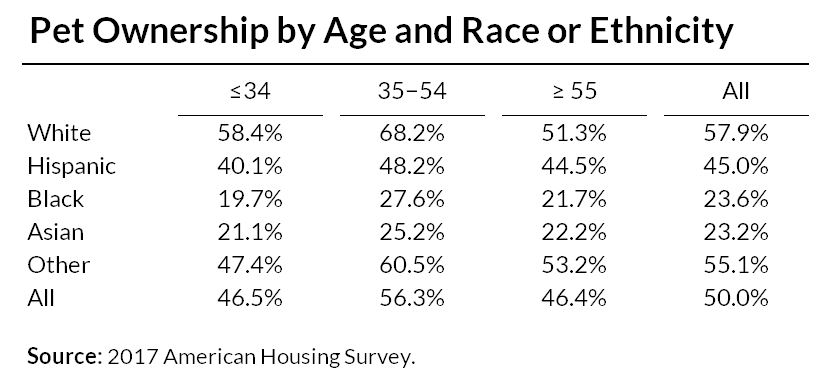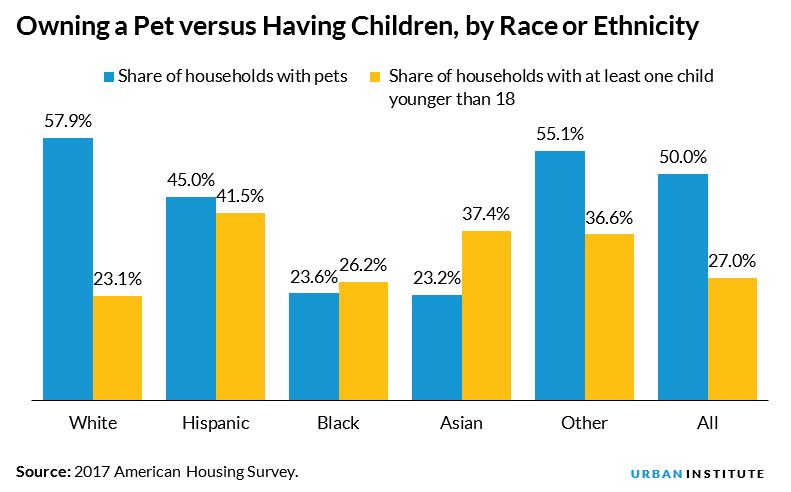From the Previous Question if the Trend Continues How Many Dogs Cats Will Be Adopted in 2013
Nearly half of US households have a pet, but we have few data on pet ownership and how it may interact with housing and demographic trends. While working with data from the 2017 American Housing Survey (AHS), we housing finance researchers were surprised to come across a question about pets; specifically whether respondents would need help with their pets in case of a disaster.
Three possible answers were offered: "yes," "no," or "I don't have pets." We were intrigued to have new data that reveal the characteristics of households with pets.
The answers don't tell us the type of pet (dog, cat, ferret), and there is no definition for what people may include as a pet—some may consider their goldfish a pet, while others might not. But because the same question was asked in 2013, we can construct a short time series and start to understand trends in pet ownership.
We noticed five interesting trends:
1. At most ages, Americans are more likely to have pets than kids.
Age is strongly associated with pet ownership. While pet ownership peaks for household heads in their 40s, the proportion of households with pets is between 40 and 60 percent for household heads in their 20s through their early 70s before tapering off.
Most folks are more likely to have a pet in their home for most of their life than a child younger than 18. Only 30-to-44-year-olds were as or more likely to have children than pets.

2. Homeowners are more likely than renters to have pets.
Fifty-seven percent of homeowners have pets compared with 37 percent of renters. This makes sense: Your landlord probably doesn't want to deal with the risk of damage from pets. But now you know the actual number to sneak into conversations at dinner parties.
3. Married adults are more apt than single adults to have pets.
Household composition also seems to be a factor in pet ownership. Married adults are more apt to be pet owners (57.0 percent) than their single counterparts (42.9 percent). But single adults are more likely to have pets than kids, particularly single men, 38.5 percent of whom have pets but only 10.2 percent of whom have children.
4. White families are the most likely to have pets but the least likely to have both pets and children.
Fifty-eight percent of non-Hispanic white families have pets compared with 45 percent of Hispanic families, 24 percent of black families, and 23 percent of Asian families. These differences are more pronounced in those younger than 35.

And while white people are the most likely to own pets, they are the least likely to also have children. Only 23.1 percent of white households had a child younger than 18, while 57.8 percent owned pets. These numbers vary widely by race or ethnicity. While black and Asian families are more likely to have kids then pets, Hispanic families and families of other races showed the opposite trend.

5. Americans are increasingly choosing pets over kids.
Over the past four years, households have become less likely to have kids and more likely to have pets. In 2013, 49.2 percent of households had pets, compared with 50.0 percent in 2017. In this same period, the share of households with kids declined from 28.6 percent to 27.0 percent. This trend was driven by a decrease in the share of millennials who have kids and an increase in the share of household heads ages 55 and older who have pets.

Why do housing finance researchers care about pets and their owners?
Pets can play an important role in where people choose to live. The millennial generation, the largest ever, has a homeownership rate 8 percentage points lower than previous generations at this point in their lives.
And while millennials are delaying marriage and having fewer children, pet ownership may become one of the driving factors for young households choosing where to settle down.
Another key reason to study pet ownership is rising prices. Rents and home prices have been rising, and these increasing costs can play a role in the choice to have children or get a pet. In the same metropolitan areas where housing costs have skyrocketed, child care costs have also increased. As these costs rise, households will continue to make trade-offs, but for some, it may be their four-legged friends who are calling the shots.
We will continue to watch this data point in future AHS releases to see how pet ownership might be affecting housing choices.

Source: https://www.urban.org/urban-wire/housing-survey-reveals-five-trends-about-american-pet-owners
0 Response to "From the Previous Question if the Trend Continues How Many Dogs Cats Will Be Adopted in 2013"
Post a Comment